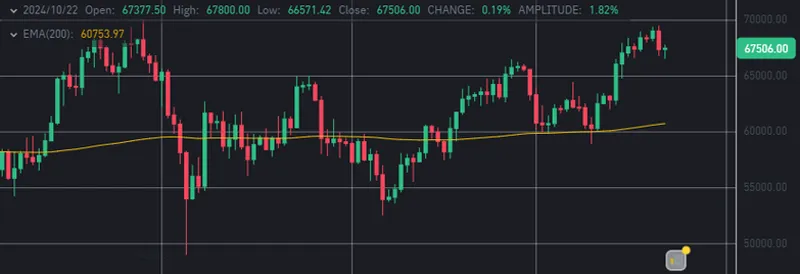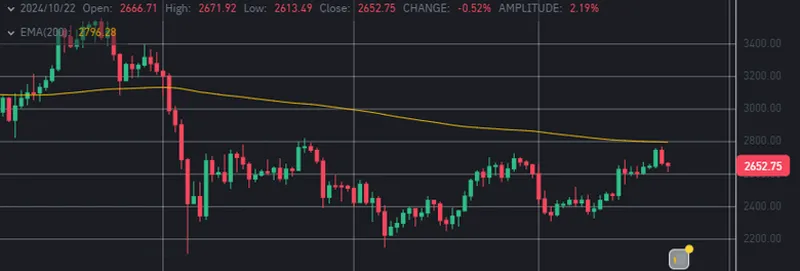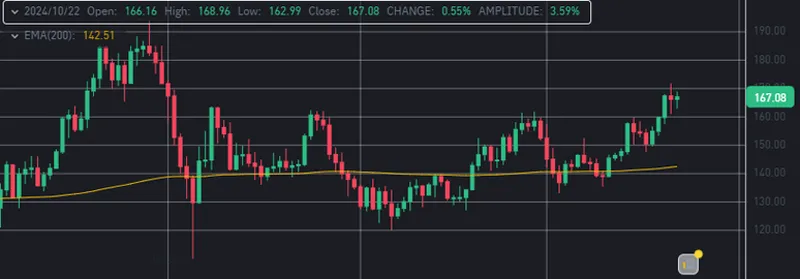Weekly Crypto Market Insights
(7 – 13 Oct 2024)
The above chart is the Bitcoin (BTC) H1 chart on TradingView for the week of 14 – 20 Oct 2024.
From the chart, the price of BTC opened at US$62,870.02 on 14 October 2024 and closed at US$69,031.99 on 20 October 2024. It marks an approximately 9.8% increase in price. The price is above the EMA200 which marks a bullish trend for now.
The above chart is the Ethereum (ETH) H1 chart on TradingView for the week of 14 – 20 Oct 2024.
From the chart, the price of ETH opened at US$2,468.92 on 14 October 2024 and closed at US$2,746.91 on 20 October 2024. It marks an approximately 11.26% increase in price. The price is below the EMA200 which marks a bearish trend for now.
The above chart is the Solana (SOL) H1 chart on TradingView for the week of 14 – 20 Oct 2024.
From the chart, the price of SOL opened at US$147.74 on 14 October 2024 and closed at US$167.4 on 20 October 2024. It marks an approximately 13.31% increase in price. The price is above the EMA200 which marks a bullish trend for now.
The above chart is the TOTAL3 H1 chart on TradingView. It shows the total market capitalization of the top-125 cryptocurrencies, excluding BTC and ETH, for the week of 14 – 20 Oct 2024.
From the chart, the market capitalization of TOTAL3 opened at US$605.211B on 14 October 2024 and closed at US$638.388B on 20 October 2024. It marks an approximately 0.44% increase in price. The market cap is above the EMA200 which marks a bullish trend for now.
The above chart is the OTHERS H1 chart on TradingView. It shows the total market capitalization of the top-125 cryptocurrencies, excluding BTC and the Top 10 cryptocurrencies, for the week of 14 – 20 Oct 2024.
From the chart, the market capitalization of OTHERS opened at US$220.188B on 14 October 2024 and closed at US$232.634B on 20 October 2024. It marks an approximately 0.97% increase in price. The market cap is above the EMA200 which marks a bullish trend.
SEC approves NYSE, CBOE listings of Bitcoin options ETFs

On Oct. 18, the United States Securities and Exchange Commission (SEC) approved applications from the New York Stock Exchange (NYSE) and the Chicago Board Options Exchange (CBOE) to list the long-anticipated options for spot Bitcoin exchange-traded funds (ETFs).
Options trading will now be available for the 11 approved ETF providers on the NYSE, including Fidelity Wise Origin Bitcoin Fund, ARK21Shares Bitcoin ETF, Invesco Galaxy Bitcoin ETF, Franklin Bitcoin ETF, VanEck Bitcoin Trust, WisdomTree’s Bitcoin Fund, Grayscale’s Bitcoin Trust, Grayscale Bitcoin Mini Trust, Bitwise Bitcoin ETF, BlackRock’s iShares Bitcoin Trust ETF, and the Valkyrie Bitcoin Fund.
The Chicago Board Options Exchange also filed an application to list options for the spot Bitcoin ETF providers in August 2024 through a proposed rule change. This change in regulatory policy puts Bitcoin ETF options in the same category as other commodity-based ETFs, which the SEC approved to be listed on the CBOE, with the exception of Grayscale’s Bitcoin Mini Trust.
Effects on markets through increased liquidity and potential short squeezes
Investors believe the introduction of options for Bitcoin ETFs will inject much-needed liquidity into the Bitcoin markets — a potential catalyst for higher price action.
Bitwise executive Jeff Park argued that the approval of options for the ETF products represented a massive upgrade from LedgerX and Deribit, which lack central guarantors.
Park also hinted at the potential for the options to create situations in which highly overleveraged short traders are “shortsqueezed” and forced to buy up Bitcoin to cover their positions:
“Saying you can’t short squeeze a trillion-dollar asset is like saying you can’t make an elephant dance. Sure, it’s huge, but if you tie enough ropes to its legs and pull hard enough, even the biggest creature can be moved in ways it doesn’t want.”
According to the managing partner of investment firm MV Global Tom Dunleavy, the introduction of options also acts as a mechanism to dampen the high volatility of Bitcoin and smooth out markets over time.
Source: https://www.tradingview.com/news/cointelegraph:ebcb004b9094b:0-sec-approves-nyse-cboe-listings-of-bitcoin-options-etfs/ This article does not contain investment advice or recommendations. Every investment and trading move involves risk, and readers should conduct their own research when making a decision.
Crypto Biz: Onchain lending ramps up, driven by institutional activity
Lending platforms are seeing a significant increase in loans processed this year. According to Ledn, a firm offering decentralized lending and savings, it registered a $1.65 billion increase compared with the same period last year.
In the third quarter of 2024, the company processed over $437 million in digital asset loans to institutions, an increase of 14% from the previous quarter. This growth is part of a wider trend of more institutions exploring digital asset-backed loans due to tighter monetary policies and intense competition for access to dollar funding.
“We saw a very healthy jump in institutional demand in July, which has remained steady since then,” said John Glover, chief investment officer at Ledn. “Institutional borrowing demand has also been fairly consistent with the overall ETF demand, where there was a similar jump in July.”
Since its launch in 2018, the company claims to have facilitated over $6.5 billion in loans across both retail and institutional markets. The combined growth in loans for the year, for both retail and institutional sectors, totaled $1.65 billion.
According to data from DefiLlama, the total value locked on lending protocols was $31.9 billion as of Oct. 16.
This week’s Crypto Biz also explores Tether’s plan to lend to traders, Grayscale’s list of potential crypto products, Ripple’s RLUSD partners and Thailand’s SCB move to stablecoins.
Tether mulls lending to commodity traders: Report
Tether Holdings is considering lending to commodities trading companies as the stablecoin issuer looks to deploy billions of dollars in profits. The stablecoin issuer has reportedly discussed lending opportunities with several commodity trading firms. According to a July 31 announcement, Tether saw record-breaking profits of $5.2 billion in the first half of 2024 and a larger-than-ever stockpile of United States government bonds. The company has been reinvesting some of its profits in adjacent industries, including sustainable energy, Bitcoin mining, data, artificial intelligence infrastructure, peer-to-peer telecommunications technology, neurotech and education.
Grayscale puts DOGE, Worldcoin on list of 35 potential crypto products
Crypto asset manager Grayscale has added 35 crypto altcoins, including Dogecoin, Worldcoin, Pyth and Rune, to a list of assets that are “under consideration” for future investment products. In an Oct. 10 blog post, Grayscale broke down its list of prospective tokens into five primary categories: Currencies, smart contract platforms, financials, culture and utilities. Most of the newly considered assets were tokens for smart-contract platforms, with the firm picking a mix of networks, including alternative layer-1 blockchains Aptos (APT) and Sei (SEI), data availability network Celestia (TIA) and Ethereum scaling solution Mantle (MNT). Grayscale also listed the tokens of several other networks, including Arbitrum (ARB), Cosmos (ATOM), Polygon (MATIC), Toncoin (TON) and Tron (TRX) as assets that are potentially worthy of becoming investment products.
Ripple announces exchange partners for RLUSD stablecoin
Ripple announced the exchange partners for its upcoming dollar-denominated stablecoin, Ripple USD (RLUSD). The blockchain infrastructure provider has partnered with cryptocurrency exchanges and platforms, including Uphold, Bitstamp, Bitso, MoonPay, Independent Reserve, CoinMENA and Bullish, to facilitate the distribution of the stablecoin. Ripple’s new stablecoin aims to become the “gold standard for enterprise-grade stablecoins,” according to Ripple CEO Brad Garlinghouse.
Thailand’s oldest bank announces stablecoin remittance services
Siam Commercial Bank (SCB), Thailand’s oldest commercial bank, recently revealed it will begin offering stablecoin cross-border payment and remittance services to its clients in collaboration with fintech company Lightnet. Adding support for stablecoin services will allow clients to send or accept cross-border transactions 24 hours a day, seven days a week — while reducing transaction costs. These reduced transaction fees make stablecoins an attractive option for those receiving remittances from higher-value currencies.
Before you go: The number of Ethereum validators has surged by over 30% in the past year, reaching over one million for the first time in June 2024, driven by strong institutional adoption of cryptocurrencies.
Source: https://www.tradingview.com/news/cointelegraph:1d3fb6449094b:0-crypto-biz-onchain-lending-ramps-up-driven-by-institutional-activity/
This article does not contain investment advice or recommendations. Every investment and trading move involves risk, and readers should conduct their own research when making a decision.
Uniswap Labs, UNI holders could make $468M a year from new L2: DeFi Report

Uniswap’s new layer 2 blockchain Unichain could be a boon for creator Uniswap Labs and holders of the project’s token, potentially earning them close to $500 million a year from fees that would’ve otherwise been paid to the Ethereum network.
Unichain’s launch would see $368 million previously paid to Ethereum validators in the last year put directly into the hands of Uniswap Labs and likely Uniswap tokenholders, DeFi Report founder Michael Nadeau said In an Oct. 13 X post.
Uniswap Labs would also be able to capture all Maximum Extractable Value (MEV) on Unchain because it owns all of the validators on the network, instead of allowing Ethereum validators to scalp MEV, he added. “MEV is estimated to be about 10% of total fees paid on Uniswap ($100m over the last year). They will have the option to share some of this with token holders as well,” Nadeau said. He added that Uniswap’s liquidity providers could also benefit from the new blockchain by being able to participate in the settlement and MEV capture through staking.
Nadeau said Ethereum validators and Ether token holders would lose the most following Unichain’s launch, with less burned ETH and fewer fees heading back to the blockchain. In the last year, Uniswap has generated over $1.3 billion in trading and settlement fees across five primary chains, including Ethereum, Optimism, BNB Chain, Base, and Polygon.
Uniswap — the largest decentralized exchange by volume — launched Unichain on Oct. 10, promising faster, cheaper transactions and improved interoperability across various blockchain networks. The launch was met with mixed sentiment from decentralized finance (DeFi) pundits, with some claiming that another layer 2 blockchain was unnecessary.
Advocates said Unichain — billed as a layer-2 network made specially for DeFi protocols — would result in a cleaner user experience for the average DeFi user, more concentrated liquidity, and fewer issues with fragmentation across various chains.
Meanwhile, skeptics found a September 2022 X post from Ethereum co-founder Vitalik Buterin which criticized the idea of a layer 2 blockchain from Uniswap.
“Uniswap’s main value proposition is that you can just go and get a trade done in 30 seconds without thinking about it,” Buterin wrote in the post. “A Uniswap chain or even rollup makes no sense in that context. A copy of Uniswap on every rollup does.”
Source: https://www.tradingview.com/news/cointelegraph:ef971ca57094b:0-uniswap-labs-uni-holders-could-make-468m-a-year-from-new-l2-defi-report/
This article does not contain investment advice or recommendations. Every investment and trading move involves risk, and readers should conduct their own research when making a decision.
The Fed’s Rate Cut Trajectory Remains Intact, Boosting the Crypto Outlook

Last week’s inflation report did little to change the Federal Reserve’s easing cycle.
Over the last few weeks, the yield on 10-year U.S. Treasury bonds has quickly jumped from 3.6% to 4.1%. The underlying driver of the change has been a swap by quant-driven fund managers. They’ve rotated out of fixedincome investments into equities. As bond prices have fallen, yields have jumped.
But that hasn’t stopped the stock-market doomsayers from trying to capitalize. They’re trying to pull every lever possible to say that stocks can’t keep rallying. But they’re not paying attention to the bigger picture story.
Lately the narrative has focused on why our central bank can’t cut interest rates. A couple of weeks ago the new government in Japan was hell bent on tightening so we couldn’t afford to cut to keep our bonds attractive. Last week, the economy was running too hot because payroll gains were stronger than anticipated, implying easing would fuel inflation.
The first story was quickly rebutted when Japan’s new prime minister said the economy can’t handle rate hikes right now. The second story was dismissed when domestic policy makers said the September employment gains aren’t enough to change the broader employment slowdown.
This week, the negative nellies were at it once again. They said higher-than-anticipated consumer price index (“CPI”) growth for September meant rate cuts are off the table. But this time like before, they weren’t focusing on the broader picture. Because if we forget about short-term expectations, we see the long-term inflation trend is headed in one steady direction down. That means our central bank will have plenty of room to lower interest rates well into next year, underpinning a steady rally in risk assets like crypto.
But don’t take my word for it, let’s look at what the data’s telling us.
The U.S. Bureau of Labor Statistics reported September CPI growth of 2.4% compared to the expectation for 2.3%. Now, while that may be a disappointment compared to what economists had predicted, when we view it relative to August’s 2.5% increase, that’s still a move in the right direction.
In the above chart, you’ll notice yesterday’s result marked the lowest rate of CPI growth since February 2021. And you can also see the metric is quickly approaching pre-pandemic levels.
But let’s drill down a little further. Let’s look at the monthly growth trend on a quarterly basis.
As you can see from the above chart, price pressures appear to have a defined trend over the course of the year. From January through March, CPI averaged a 0.6% increase. In the April through June span, prices increased at a rate of 0.3%. And for the last three months, the pace of growth has held steady around 0.1%. Clearly a steady slowdown.
So now, we want to go back and look at the trend over the last few years. This way we can see if the activity this year is out of whack.
Well, based on the numbers since 2021, the rate of monthly inflation growth tends to slow throughout the year. And as we’ve moved further away from the effects of COVID stimulus, we can see the slowdown has accelerated.
Our chart shows us that inflation growth typically runs the hottest in the first two quarters of the year. Then, in the third and fourth quarters, it can slow to almost a crawl. In fact, in the fourth quarter of 2022 there wasn’t any growth, while the end of last year saw CPI contract. The implication being inflation growth should slow more over the next three months.
But we want to get an idea of whether economic trends are returning to normal. Because, if they are, it means the Fed can also return interest rates back to more normal levels. So, let’s look at what the pace of monthly growth has done the last few years relative to the pre-pandemic average.
In 2021-2022, when inflation was exploding higher, the average pace of monthly growth was 0.6%. In other words, CPI expanded at roughly 7.2% per year. But as interest rates shot up, the pace of monthly growth has slowed. In 2023, the average month-over-month growth was 0.3%, or 3.6% annualized, while year-to-date it has averaged 0.2%, or 2.4% annualized. For pre-COVID levels, I ran the numbers from 2009 through 2019. What I found was that inflation rose just over 0.15% per month.
Based on the numbers, it would appear the trend for inflation is returning back toward pre-pandemic levels of normal. So, I modeled what annualized growth would look like if that’s the trend going forward.
Based on the result, CPI could be back below the Fed’s 2% target as soon as February. In other words, within the next five months, our central bank could be close to achieving one of its primary goals since it started raising rates in March 2022.
The last thing we want to look at is what kind of room the Fed has to lower rates. Well, the difference between the effective fed funds rate and annualized CPI growth, following the release of the September data, sits at 250 basis points.
That’s one of the highest levels going back to 2000. More importantly, it tells us that the Fed can lower rates by that same amount before policy no longer weighs on inflation.
So, like I said at the start, the stock-market boo-birds are trying everything they can to try and get equity prices lower. But in the process, they’re hoping everyone will get caught up in the noise and not pay attention to the signal.
Currently, Wall Street expects borrowing costs to drop from 4.9% today to 3.4% by October of next year. Based on the numbers we just looked at, the Fed has plenty of room to do that right now. And it would still have a cushion of another 100 basis points.
Source: https://www.tradingview.com/news/coindesk:b5f2a8a90094b:0-the-fed-s-rate-cut-trajectory-remains-intact-boosting-the-crypto-outlook/
This article does not contain investment advice or recommendations. Every investment and trading move involves risk, and readers should conduct their own research when making a decision.

BlackRock Exec: 75% of Bitcoin ETF Investment Comes From Crypto Fans, Not Wall Street
ABlackRock ETF head Samara Cohen has told CNBC that most demand for Bitcoin comes through investment tools like ETFs, not direct purchases from crypto exchanges.
She highlighted that 80% of Bitcoin ETF buyers are direct investors, and 75% are first-time buyers of BlackRock’s iShares products.
The total market cap of all 11 spot Bitcoin ETFs has reached over $63 billion, with nearly $20 billion in inflows. In the last five trading days, spot Bitcoin ETFs saw over $2.1 billion in net inflows, with BlackRock responsible for half.
Bitcoin hit its highest price since July, trading above $68,300, ending Q3 up 140% year-over-year. Cohen also emphasized that they initially aimed to educate ETF investors about crypto, but instead found themselves teaching crypto investors about the benefits of ETFs.
New Bitcoin ETF options
On Friday, the U.S. Securities and Exchange Commission (SEC) granted accelerated approval for 11 exchange-traded funds (ETFs) to list and trade options tied to spot Bitcoin prices on the New York Stock Exchange (NYSE).
This marks an important step forward for institutional investors, as Bitcoin options provide a flexible and efficient tool for hedging and amplifying exposure to Bitcoin.
These options offer investors a way to speculate or hedge risks related to Bitcoin’s price movements in a regulated market, with less capital required compared to trading the actual asset.
Bloomberg analyst Eric Balchunas has commented on yet another historic moment for the crypto market. According to him, the SEC approved the same thing for Nasdaq recently, so this news doesn’t come as a major surprise, despite being positive news for crypto in general.
They approved same thing for Nasdaq recently so not a big surprise but still good news as SEC was big hurdle. We hearing good things about the rest of process altho exact timeline for listing date still unclear. https://t.co/N9squVSXfS— Eric Balchunas (@EricBalchunas) October 18, 2024.
However, the actual listing will require more time, as the new options still need CFTC approval, Balchunas said.

Bitcoin returns surpass expectations
Bitcoin closed Q3 with a modest 1.00% gain, recovering after dropping below $50,000 in August, according to CCData. As we head into Q4, market sentiment has turned bullish, supported by historical data showing an average return of 49.9% in Q4 since 2014.
This optimism is reinforced by a shift in market dynamics following the Federal Reserve’s interest rate cut of 50 basis points. The cut boosted market activity, with Bitcoin’s aggregated open interest jumping 6% to nearly $27 billion. Source: CCData
Bitcoin’s price surged past $62,000, reflecting a strong bullish response, and altcoins followed suit, outperforming U.S. equities, which saw volatile movements.
This outperformance in the crypto market suggests that liquidity injections could follow, as the rate cut often indicates macroeconomic weakness after a multi-year tightening cycle.
If further economic stimulus is required, risk-on assets like Bitcoin are expected to benefit most, with upward momentum likely to continue in the near term.
Source: https://www.tradingview.com/news/u_today:8ff0afc6c094b:0-blackrock-exec-75-of-bitcoin-etf-investment-comes-from-crypto-fans-not-wall-street/
This article does not contain investment advice or recommendations. Every investment and trading move involves risk, and readers should conduct their own research when making a decision.







